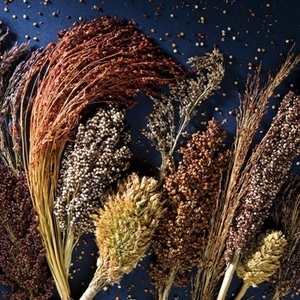DOE funds pilot study focused on biosecurity for bioenergy crops

SOURCE: U.S. Department of Energy Genomic Science program
October 12, 2022
BY U.S. Department of Energy, Brookhaven National Laboratory
The U.S. Department of Energy’s Office of Science has selected Brookhaven National Laboratory to lead a new research effort focused on potential threats to crops grown for bioenergy production. Understanding how such bioenergy crops could be harmed by known or new pests or pathogens could help speed the development of rapid responses to mitigate damage and longer-term strategies for preventing such harm. The pilot project could evolve into a broader basic science capability to help ensure the development of resilient and sustainable bioenergy crops as part of a transition to a net-zero carbon economy.
The idea is modeled on the way DOE’s National Virtual Biotechnology Laboratory pooled basic science capabilities to address the COVID-19 pandemic. With $5 Million in initial funding, allocated over the next two years, Brookhaven Lab and its partners will develop a coordinated approach for addressing biosecurity challenges. This pilot study will lead to a roadmap for building out a DOE-wide capability known as the National Virtual Biosecurity for Bioenergy Crops Center (NVBBCC).
“A robust biosecurity capability optimized to respond rapidly to biological threats to bioenergy crops requires an integrated and versatile platform,” said Martin Schoonen, Brookhaven Lab’s Associate Laboratory Director for Environment, Biology, Nuclear Science & Nonproliferation, who will serve as principal investigator for the pilot project. “With this initial funding, we’ll develop a bio-preparedness platform for sampling and detecting threats, predicting how they might propagate, and understanding how pests or pathogens interact with bioenergy crops at the molecular level—all of which are essential for developing short-term control measures and long-term solutions.”
The team will invest in new research tools—including experimental equipment and an integrating computing environment for data sharing, data analysis, and predictive modeling. Experiments on an important disease of energy sorghum, a leading target for bioengineering as an oil-producing crop, will serve as a model to help the team establish optimized protocols for studying plant-pathogen interactions.
In addition, a series of workshops will bring together experts from a range of perspectives and institutions to identify partnerships within and outside DOE, as well as any future investments needed, to establish the full capabilities of an end-to-end biosecurity platform.
“NVBBCC is envisioned to be a distributed, virtual center with multiple DOE-labs at its core to maximize the use of unique facilities and expertise across the DOE complex,” Schoonen said. “The center will support plant pathology research driven by the interests of the bioenergy crop community, as well as broader plant biology research that could impact crop health.”
Advertisement
Advertisement
Building the platform
Both the workshops and experiments will be organized around the center’s four main themes: detection and sampling, biomolecular characterization, assessment, and mitigation.
In this initial phase, the research will focus on energy sorghum. This crop’s potential oil yield per acre far exceeds than that of soybeans, currently the world’s primary source of biodiesel.
"Sorghum is susceptible to a devastating fungal disease, caused by Colletotrichum sublineola, which can result in yield losses of up to 67 percent,” said John Shanklin, chair of Brookhaven Lab’s Biology Department and co-lead of the assessment theme. “Finding ways to thwart this pathogen is a high priority for the bioenergy crop community.”
The NVBBCC team will use a range of tools—including advanced remote-sensing technologies, COVID-19-like rapid test strips, and in-field sampling—to detect C. sublineola. Additional experiments will assess airborne propagation of fungal spores, drawing on Brookhaven Lab’s expertise in modeling the dispersal of aerosol particles.
The team will also use state-of-the-art biomolecular characterization tools—including cryo-electron microscopes in Brookhaven’s Laboratory for BioMolecular Structure (LBMS) and x-ray crystallography beamlines at the National Synchrotron Light Source-II (NSLS-II)—to explore details of how pathogen proteins and plant proteins interact. In addition, they’ll add a new tool—a cryogenic-focused ion beam—to produce samples for high-resolution three-dimensional cellular imaging and other advanced imaging modalities.
Advertisement
Advertisement
Together, these experiments will reveal mechanistic details that provide insight into how plants respond to infections, including how some strains of sorghum develop resistance to C. sublineola. The team will also draw on extensive information about the genetic makeup of sorghum and C. sublineola to identify factors that control expression of the various plant and pathogen proteins.
The program will be supported by an integrating computing infrastructure with access to sophisticated computational tools across the DOE complex and at partner institutions, enabling integrated data analysis and collaboration using community data standards and tools. The infrastructure will also provide capabilities to develop, train, and verify new analytical and predictive computer models, including novel artificial intelligence (AI) solutions.
“NVBBCC will build on the Johns Hopkins University-developed SciServer environment, which has been used successfully in large data-sharing and analysis projects in cosmology and soil ecology,” said Kerstin Kleese van Dam, head of Brookhaven Lab’s Computational Science Initiative. “NVBBCC’s computational infrastructure will allow members to easily coordinate research across different domains and sites, accelerating discovery and response times through integrated knowledge sharing.”
Brookhaven National Laboratory is supported by the Office of Science of the U.S. Department of Energy. The Office of Science is the single largest supporter of basic research in the physical sciences in the United States and is working to address some of the most pressing challenges of our time. For more information, visit science.energy.gov.
Related Stories
The USDA significantly increased its estimate for 2025-’26 soybean oil use in biofuel production in its latest World Agricultural Supply and Demand Estimates report, released July 11. The outlook for soybean production was revised down.
U.S. fuel ethanol capacity fell slightly in April, while biodiesel and renewable diesel capacity held steady, according to data released by the U.S. EIA on June 30. Feedstock consumption was down when compared to the previous month.
The U.S. EPA on July 8 hosted virtual public hearing to gather input on the agency’s recently released proposed rule to set 2026 and 2027 RFS RVOs. Members of the biofuel industry were among those to offer testimony during the event.
The USDA’s Risk Management Agency is implementing multiple changes to the Camelina pilot insurance program for the 2026 and succeeding crop years. The changes will expand coverage options and provide greater flexibility for producers.
The USDA’s National Agricultural Statistics Service on June 30 released its annual Acreage report, estimating that 83.4 million acres of soybeans have been planted in the U.S. this year, down 4% when compared to 2024.
Upcoming Events










